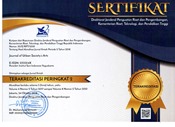Concept (間) MA: Philosophical Identification and Analysis in Animated Films Howl’s Moving Castle (2004)
Abstract
In the context of Japanese film, MA is an important concept to highlight because of its great influence on filmmaking and audience experience. In the visual arts, “MA” can be interpreted as “space” or “interval”; MA can also be said to be the core of aesthetic principles. The purpose of this study is to find and identify the philosophical aspects of the concept of MA in the scenes found in the animated film Howl’s Moving Castle (2004) to gain an understanding of visual aesthetics as well as to understand how the concept of MA works and is used in the visual aesthetics of Ghibli animated films. The research methodology on the concept of MA involves a multidimensional approach that includes visual language methods, literature study, and content analysis, as well as a combination of theories on emptiness and tensegrity structure. The analysis shows that the number of scenes containing MA factors is 17 scenes; the total scenes in the movie are about 2,301 scenes, with the assumption that each scene averages 3 seconds. The 17 scenes only take up a portion of 0.73%, a relatively flat number; then, if we take the duration of time for each scene, a value shows the total scene that contains MA factors is 333 Seconds or 5.55 minutes while the total duration of the Howl’s Moving Castle animated film is 01:55:05 minutes or about 6,905 seconds the MA transition scene is 4.8% of the total film. The research can provide an in-depth insight into the use of MA in the context of animated films, where it can provide an understanding of how seemingly simple visual elements, such as empty space, can have a strong impact on the audience’s experience and level of engagement, or understanding of the story and characters.
Dalam konteks film Jepang, MA merupakan konsep yang penting disorot karena pengaruhnya yang besar terhadap pembuatan film dan pengalaman penonton. “MA” dapat diartikan sebagai “ruang” atau “interval”, yang juga sebagai inti dari prinsip estetika. Tujuan dari penelitian ini adalah mencari dan mengidentifikasi aspek filosofis, konsep MA pada scene yang terdapat pada film animasi Howl’s Moving Castle (2004) untuk mendapatkan pemahaman tentang estetika visual sekaligus untuk memahami bagaimana konsep MA bekerja dan digunakan dalam estetika visual film-film animasi Ghibli. Metodologi penelitian tentang konsep MA melibatkan pendekatan multidimensi yang mencakup metode bahasa visual, studi literatur dan analisis konten, serta kombinasi teori tentang emptiness dan tensegrity structure. Analisis menunjukan banyaknya scene yang mengandung MA factor adalah 17 scene, total scene dalam film ada sekitar 2,301 scene dengan durasi rata-rata setiap scene sebesar 3 detik. 17 scene tersebut hanya memakan porsi sebesar 0.73 %, dengan total scene yang terdapat MA faktor sebanyak 333 Second atau 5.55 menit sedangkan total dari durasi film animasi Howl’s Moving Castle sebanyak 01:55:05 menit atau sekitar 6,905 detik maka scene transisi MA sebesar 4.8 % dari total keseluruhan film. Penelitian ini dapat memberikan wawasan mendalam tentang penggunaan MA dalam konteks film animasi, dimana hal tersebut dapat memberikan pemahaman bagaimana elemen-elemen visual yang tampak sederhana, seperti ruang kosong, dapat memberikan dampak yang kuat terhadap pengalaman penonton dan tingkat keterlibatan, atau pemahaman penonton terhadap cerita dan karakter.
Keywords
Full Text:
PDFReferences
Abbara, N. (2021). Humanizing Architecture: A Polymorphic Space [Thesis, Virginia Commonwhealth University]. https://doi.org/10.25772/BFT6-9B11
Akama, Y. (2014). Attuning to Ma (between-Ness) in Designing. Proceedings of the 13th Participatory Design Conference: Short Papers, Industry Cases, Workshop Descriptions, Doctoral Consortium Papers, and Keynote Abstracts - Volume 2, 21–24. https://doi.org/10.1145/2662155.2662179
Bartolomei, C., Ippolito, A., & Mezzino, D. (2023). Representation of Landscape and Ecological Vision in Miyazaki’s Filmography. Sustainability, 15(20). https://doi.org/10.3390/su152015132
Bendix, C. (2023). Diana Wynne Jones, Howl’s Moving Castle. In Reading Matters (pp. 33–37). Göttingen University Press. DOI: https://doi.org/10.17875/gup2023-2241
Brigitte Naderer, J. M., & Spielvogel, I. (2019). How brands appear in children’s movies. A systematic content analysis of the past 25 Years. International Journal of Advertising, 38(2), 237–257. https:// doi.org/10.1080/02650487.2017.1410000
Campisi, A. (2020, September 22). Howl’s Moving Castle: Film Review. Loudandclearreviews-Com. https://loudandclearreviews-com.translate.goog/howls-moving-castle-review/?_x_tr_sl=en&_x_tr_ tl=id&_x_tr_hl=id&_x_tr_pto=tc&_x_tr_hist=true
Canning, D. (2016). Ma. Uniquejapan.Com. https://new.uniquejapan.com/ikebana/ma/
Crombie, Z. (2021). The Spectacular Mundane in the Films of Studio Ghibli. Journal of Anime and Manga Studies, 2, 1–26. https://doi.org/10.21900/j.jams.v2.507
Croteau, M. (2022). Transcendence and Spirituality in Japanese Cinema Framing Sacred Spaces (1st Edition).Routledge.
Domínguez-Delgado, R., & Hernández, M.-Á. L. (2016). The retrieval of moving images at Spanish film archives: The oversight of content analysis. Proceedings of the Association for Information Science and Technology, 53(1), 1–4. https://doi.org/10.1002/pra2.2016.14505301140
Ejaz, X. (2022). Confronting Coming of Age and War in Hayao Miyazaki’s Howl’s Moving Castle (2004). The International Academic Forum (IAFOR), 11(1), 7–19. https://doi.org/10.22492/ijl.11.1.01
Fazeli, S., Sabetti, J., & Ferrari, M. (2023). Performing Qualitative Content Analysis of Video Data
in Social Sciences and Medicine: The Visual-Verbal Video Analysis Method. International Journal of Qualitative Methods, 22, 16094069231185452. https://doi.org/10.1177/16094069231185452
Frisch, S. (2019). The Aesthetics of Flow and Cut in the Way of Film: Towards Transnational Transfers of East Asian Concepts to Western Film Theory. Arts, 8(3). https://doi.org/10.3390/arts8030119
Graham, P. (2014). Japanese Design: Art, Aesthetics & Culture. Tuttle Publishing. https://books.google.co.id/books?id=8W_oBAAAQBAJ
Greenland, K. B. (2015). Art of airway management: The concept of ‘Ma’ (Japanese: 間, when ‘less is more’). BJA: British Journal of Anaesthesia, 115(6), 809–812. https://doi.org/10.1093/bja/aev298
Griffin, N. (2020, May 10). Feature: Howl’s Moving Castle examines war by focusing on its victims. Counteract.Co. https://counteract.co/film-and-tv/feature-howls-moving-castle/
Hamaguchi, R. (Director). (2022, February 8). MA in Japanese Film | In Conversation with Film Director. https://www.international.ucla.edu/japan/event/15401
Harriger, J. A., Serier, K. N., Luedke, M., Robertson, S., & Bojorquez, A. (2018). Appearance-related themes in children’s animated movies released between 2004 and 2016: A content analysis. Body Image, 26, 78–82. https://doi.org/10.1016/j.bodyim.2018.06.004
Haryanti, P., & Nurlatifah, Y. (2018). Visual Language in Japanese Animation. Proceedings of the International Conference on Business, Economic, Social Science and Humanities (ICOBEST 2018), 280–282. https://doi.org/10.2991/icobest-18.2018.61
Hernández-Pérez, M. (2016). Animation, Branding and Authorship in the Construction of the ‘Anti- Disney’ Ethos: Hayao Miyazaki’s Works and Persona through Disney Film Criticism. Animation, 11(3), 297–313. https://doi.org/10.1177/1746847716660684
Jiaqi Xia. (2021). The Application of Maximalism in Film Production. Proceedings of the 2021 3rd International Conference on Literature, Art and Human Development (ICLAHD 2021), 96–99. https://doi.org/10.2991/assehr.k.211120.019
Kernaghan, C. (2021, December 30). How Minimalism and the Japanese Concept of “Ma” 間 Defined Ico Subtraction in a world of excess. Medium.Com. https://medium.com/super-jump/how-minimalism- and-the-japanese-concept-of-ma-間-defined-ico-96f86fed78e5
Kodama, M. (2017a). Knowledge Convergence through “Ma Thinking.” Knowledge and Process Management, 24(3), 170–187. https://doi.org/10.1002/kpm.1541
Kodama, M. (2017b). Ma Theory and the Creative Management of Innovation. Palgrave Macmillan. https://doi.org/DOI 10.1057/978-1-137-59194-4
Kono, T. (2019). Phenomenology of Ma and Maai: An Interpretation of Zeami’s Body Cosmology from a Phenomenological Point of View. New Generation Computing, 37(3), 247–261. https://doi. org/10.1007/s00354-019-00060-4
Lanki, C. (2013, February 7). 間: An aesthetic of space-time. Ricepapermagazine.Ca. https:// ricepapermagazine.ca/2013/02/間-an-aesthetic-of-space-time/
Leardi, L. (2019, March 6). Arata Isozaki on “Ma,” the Japanese Concept of In-Between Space. Archdaily. Com. https://www.archdaily.com/882896/arata-isozaki-on-ma-the-japanese-concept-of-in-between- space
Lee, L. (2015). Japan’s Cinema of Tricks: Optical Effects and Classical Film Style. Quarterly Review of Film and Video, 32(2), 141–161. https://doi.org/10.1080/10509208.2013.811351
Lucas, T., & Rahim, R. A. (2017). The Similarities and Nuances of Explicit Design Characteristics of Well-Received Online Instructional Animations. Animation, 12(1), 80–99. https://doi. org/10.1177/1746847717690671
Lucken, M., & Rosen, M. (2021). The Limits of ma: Retracing the Emergence of a “Japanese” Concept. Journal of World Philosophies, 6(1), 38–57.
Maruyama, T. (Director). (2020). Shashin no Ma [Documentary; Colour]. https://americas.dafilms. com/film/11716-shashin-no-ma
Matsumoto, K. (2020, April 24). MA — The Japanese Concept of Space and Time. Medium. https:// medium.com/@kiyoshimatsumoto/ma-the-japanese-concept-of-space-and-time-3330c83ded4c
Nitschke, G. (2018, May 16). MA: Place, Space, Void. Kyotojournal.Org. https://www.kyotojournal. org/culture-arts/ma-place-space-void/
Pugsley, Peter. C. (2016). Tradition, Culture and Aesthetics in Contemporary Asian Cinema. Taylor & Francis.
Reynolds, C. C. (2023). Spaces Between Exploring Ma as a Literary Theory [University of Massachusetts Amherst]. https://doi.org/10.7275/35648470
Tseng, C., Cheng, M., Matout, H., Fujita, K., Kitamura, Y., Shioiri, S., Ho, I.-L., & Bachrach, A. (2021). MA and Togetherness (Ittaikan) in the Narratives of Dancers and Spectators: Sharing an Uncertain Space. Japanese Psychological Research, 63(4), 421–433. https://doi.org/10.1111/jpr.12330
Wilson, C., & Wilson, Garrath T. (2016). Taoism, Shintoism, and the Ethics of Technology An Ecocritical Review of Howl’s Moving Castle. Resilience: A Journal of the Environmental Humanities, 2(3), 189–194. https://doi.org/10.5250/resilience.2.3.0189
Yudhanto, S. H., Risdianto, F., & Artanto, A. T. (2023). Cultural and Communication Approaches in the Design of Visual Communication Design Works. Journal of Linguistics, Culture, and Communication, 1(1), 79–90. https://doi.org/10.61320/jolcc.v1i1.79-90
DOI: https://doi.org/10.24821/jousa.v11i2.12423
Refbacks
- There are currently no refbacks.

This work is licensed under a Creative Commons Attribution 4.0 International License. ISSN 2355-2131 (print) | ISSN 2355-214X (online).






